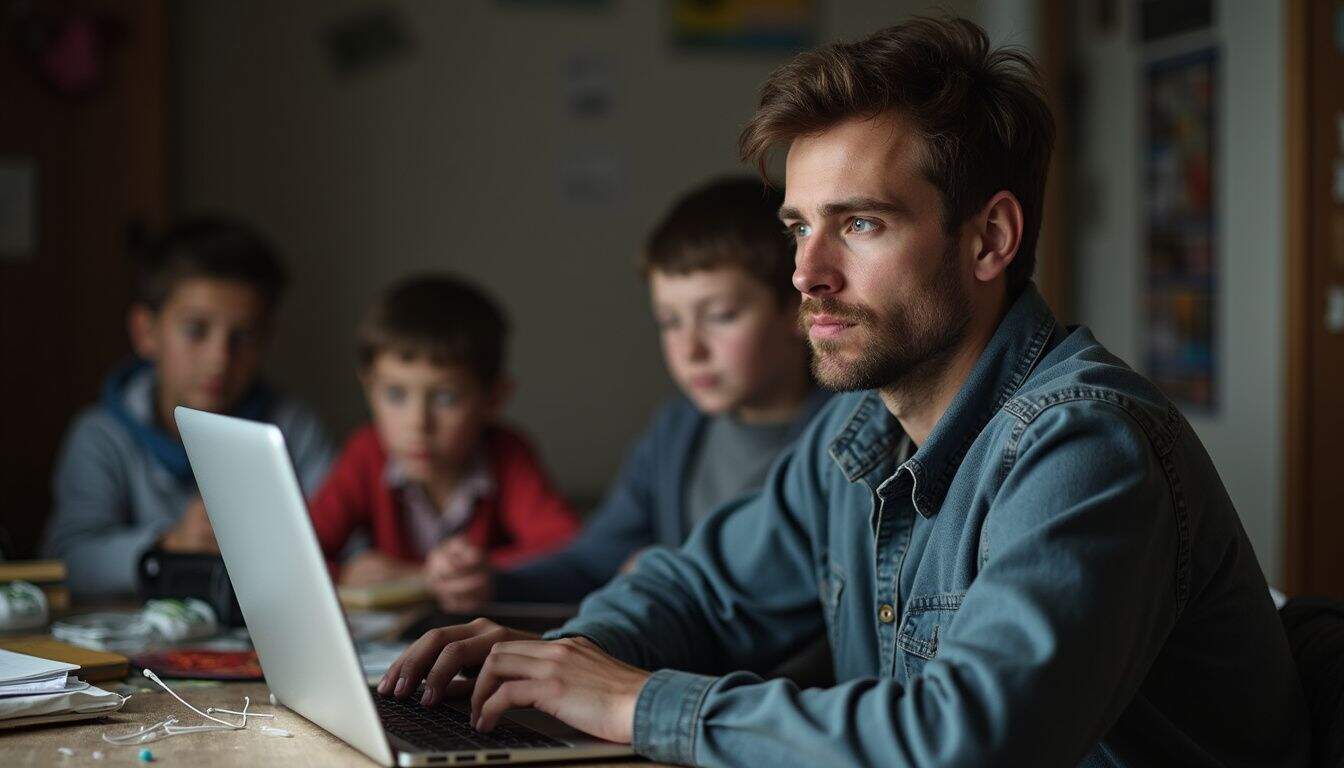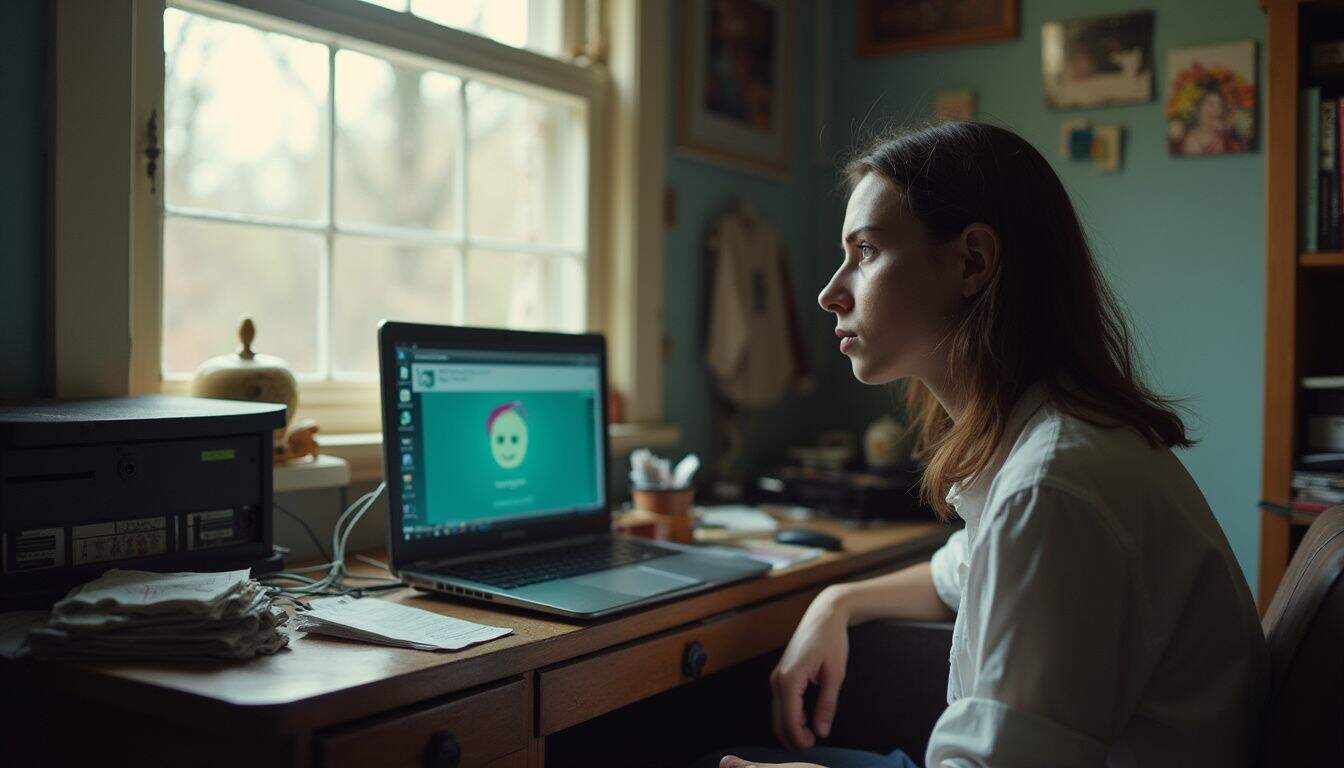Millions of people are asking what happened to Omegle after the popular chat site suddenly disappeared in November 2023. The website connected strangers through random video chats for 14 years. At its peak, it attracted 73 million visitors every month from countries around the world.
This article explains the real reasons behind Omegle’s shutdown. You’ll learn about its rapid growth during COVID-19 and the serious legal battles that forced it to close. The story shows how a simple idea turned into both a global sensation and a warning about online safety.
Key Takeaways
Omegle closed on November 9, 2023, after its founder Leif K-Brooks faced huge legal problems. A $22 million lawsuit from Oregon involved child exploitation cases. The site had 73 million monthly visitors during COVID-19 but lacked proper moderation and safety measures.
The platform reported 608,000 cases of possible child exploitation in 2022. The Internet Watch Foundation saw cases jump from 5,000 to 63,000 webpages during the pandemic. BBC investigations found children as young as seven using the site without any restrictions, which led to many abuse cases.
TikTok banned all Omegle links after reports showed minors performing sexual acts on the platform. The site had just one person, Brooks, running moderation from Florida. This wasn’t enough for a global platform that worked in 41 languages with users from India, US, UK, Mexico, and Australia.
The UK’s Online Safety Act and new digital platform rules forced Omegle to close. This marked a major change toward better safety measures in anonymous video chat services. Users have switched to alternatives like Chatrandom and Monkey, which have stronger content filtering and user protection features.
Table of Contents
What is Omegle?

Omegle launched in 2009 as a free online chat website that paired random strangers for conversations. The site became an instant hit. It got 150,000 daily page views in just its first month.
People could chat through text, voice, and video without making accounts or giving out personal details. The platform had three different chat modes. There was Adult Chat for explicit content, Moderated Chat with some oversight, and Unmoderated Chat that came with age warnings.
The site added video chat in March 2010. It also let users match based on shared interests using tags. Before 2013, there were no profanity filters at all. This made it a completely unregulated space for online conversations.
Today, Thundr has emerged as a modern alternative that addresses many of Omegle’s shortcomings. Thundr isn’t just “Omegle 2.0” – it’s a complete reimagining of random chat for today’s users. Built specifically for 2025, it works seamlessly across all devices – desktop and mobile browsers – without requiring any downloads or glitchy add-ons. Like Omegle, Thundr maintains the no-account, no-data-harvesting approach that made random chatting appealing in the first place.
You simply grant camera and microphone access, hit “Start,” and you’re instantly connected with someone anywhere in the world. While Thundr offers optional premium filters like gender selection, the core service remains free and accessible to everyone, delivering spontaneity without the spam, friction, or privacy risks that plagued its predecessor.
The Rise of Omegle

Omegle exploded in popularity during the 2020 lockdowns. Teens rushed to the platform for random video chats and social connections. The site’s simple design and anonymous interactions drew millions of users. They wanted to meet strangers online without sharing personal information.
Why did Omegle become popular among teens and young adults?

The COVID-19 lockdowns changed how people used social media in 2020. Teens and young adults turned to anonymous chat platforms to fight loneliness. They needed new ways to connect with others.
- The platform’s free access attracted millions of users. They wanted quick chats without making accounts or sharing personal information.
- Social distancing forced people to find new ways to meet online. Video chat sites like Omegle became perfect for isolated teens.
- Big influencers on TikTok and Instagram started making Omegle content. This created viral trends that spread quickly among young users.
- Students used the site to meet people from other countries. They practiced foreign languages and learned about different cultures.
- The text chat feature helped shy users feel comfortable. They could start conversations without showing their faces.
- Large communities formed from India, the US, UK, Mexico, and Australia. This created a diverse mix of people available to chat anytime.
- The platform’s simple interface made chatting instant and easy. Other social networks needed complex profile setups first.
- Teens found freedom in anonymous conversations. They could discuss topics they might avoid on regular social media.
- Live streaming features let users share talents and stories. They could reach global audiences without fear of judgment.
- The random matching system created excitement and surprise. Each new chat felt like an adventure waiting to happen.
- Young adults liked meeting people outside their usual social circles. They could connect with strangers from different communities worldwide.
What are the unique features of Omegle?

Omegle had a special interest-based matching system that set it apart from other chat sites. Users typed in tags to find people who liked the same things. The platform worked in 41 languages worldwide.
No account creation meant people could start chatting immediately. The site had a unique “spy” mode too. One person asked questions while two strangers discussed the topic. This created an interesting three-way conversation format.
Omegle broke down language barriers and connected people globally through shared interests – Leif K-Brooks, Omegle founder
Text and video chat options gave users choices in how they connected. Private webcam feeds allowed face-to-face talks. The interest matching system helped create better connections between strangers.
The free platform made random chats available to anyone with internet access. These features later raised serious concerns about online safety and user protection. Many controversies followed as a result.
Controversies Surrounding Omegle

Omegle faced huge criticism for its weak safety measures. The platform didn’t protect users from sexual predators. It became a dangerous place for online child abuse. Countless reports showed minors encountering explicit content and harmful behavior on the site.
How does Omegle handle moderation?

Leif K-Brooks managed Omegle’s moderation system by himself from Florida. This setup failed badly for a global chat platform. The site didn’t have enough human moderators to check content or handle user complaints. Problems got worse when Brooks was offline.
Users constantly saw explicit material because the content filtering was so weak.
The platform did have a “Moderated Chat” option, but it didn’t work well. It couldn’t stop inappropriate content from appearing. In 2022, the site finally limited access to users 18 and older. This change came way too late. Years of poor controls had already caused serious safety problems and legal troubles.
The basic moderation setup turned the platform into a magnet for online abuse. Cyberbullying became common. Young users faced constant risks every time they logged on.
What inappropriate content can users encounter on Omegle?

Weak moderation on Omegle created serious dangers for users. The platform became filled with inappropriate content that put people at risk. Minors faced the worst dangers.
- Male users often exposed themselves through explicit acts and nudity during video chats. This created an unsafe space for everyone.
- Sexual predators used the site for online grooming. They targeted vulnerable users with manipulative conversations and requests.
- Racist content spread quickly during COVID-19. Alt-right users like Tor Brookes promoted hate speech and conspiracy theories.
- Users suffered psychological trauma from seeing unexpected graphic content. The platform had no proper content filters to stop this.
- The Anti-Defamation League found widespread antisemitism in 2020. Far-right trolls were active across the platform.
- Sexual exploitation happened often. Some users recorded and shared inappropriate content without getting permission first.
- Cyberbullying happened frequently in text chats. Trolls targeted minorities and vulnerable users constantly.
- Child sexual abuse materials appeared on the platform. There were no age verification systems before 2013.
- Users got malware through malicious links shared in chats.
- The platform saw increases in self-harm content. Dangerous viral challenges put young users at serious risk.
- False information spread quickly through chat sessions. Users shared fake news and conspiracy theories constantly.
- Sexual abuse cases increased as predators used anonymity. They could target victims without being identified.
What are the safety concerns related to cybergrooming on Omegle?

Omegle’s missing safety measures created huge risks for young users. The Internet Watch Foundation discovered a shocking increase in sexual content involving minors. Cases jumped from 5,000 before COVID-19 to 63,000 webpages in 2022.
BBC investigations found children as young as seven using the platform. There were no restrictions at all. The lack of parental controls and proper moderation made it simple for predators to find vulnerable kids.
The platform became a breeding ground for online predators during COVID-19 lockdowns – UK Online Safety Regulator
Sexual exploitation thrived because of Omegle’s recording features. Users saved and shared conversations without asking permission. This led to widespread abuse across the platform. TikTok banned all Omegle links after finding reports of children performing sexual acts.
The platform never added basic safety tools like report buttons or age checks. Young users were left exposed to dangerous situations. Many victims experienced anxiety and trauma from what happened to them on the site.
Legal Issues and Lawsuits

Omegle faced several lawsuits from parents whose children were sexually abused on the platform. These cases led to expensive legal fees and settlements. The mounting pressure finally forced the company to shut down. Read on to discover the shocking details behind these legal battles.
What child exploitation cases have involved Omegle?

Child exploitation cases on Omegle shocked people around the world. Legal records reveal disturbing patterns of predatory behavior through the platform’s video chat feature.
- A Canadian teacher was arrested in 2020 for streaming child pornography on the platform. He admitted guilt in 2022 and went to jail.
- An Australian predator got caught in 2021 using the chat service to target minors for sexual abuse. Police tracked his online activities through multiple browsers and message boards.
- A major case came from Norway in 2025. A man in his 30s sexually abused more than 30 children between ages 8 and 12. He used the livestream features to commit these crimes.
- The platform reported 608,000 cases of potential child exploitation in 2022. These reports went to the National Center for Missing and Exploited Children. They helped track criminals across different web platforms.
- A landmark $22 million lawsuit came from an Oregon teenager called “A.M.” The case showed how a Canadian pedophile forced an 11-year-old girl into digital sexual acts in 2014.
- Trial attorneys proved the platform failed to warn users about predator risks. This failure led to multiple victims getting sexually abused through random video matches.
- Law enforcement connected the chat platform to over 50 pedophile cases in recent years. These crimes raised major concerns about online safety and child protection measures.
- The final lawsuit pushed the platform to close for good. The company admitted A.M.’s case exposed the human cost of poor safety measures.
What legal actions and settlements has Omegle faced?

Omegle faced serious legal troubles throughout its operation. Multiple lawsuits targeted the platform for enabling criminal activities and exploitation.
- A minor filed a lawsuit in November 2021, demanding $22 million. The case focused on product liability and failure to warn users about dangers. The minor had been matched with a predator on the platform.
- Lawyers took cases against Omegle on contingency fees. Victims paid nothing unless they won compensation. This made legal action easier for exploitation survivors.
- Legal teams proved Omegle made money from ads and sponsored chats. Criminal activities happened on the platform at the same time. This became a key part of many lawsuits.
- Victims sought damages for medical care and mental health treatment. They also wanted compensation for lost wages and trauma. Courts allowed these claims despite Omegle’s terms of service.
- Most legal actions targeted Omegle directly, not individual wrongdoers. The company had more money to pay compensation than individual criminals did.
- Courts protected minor victims’ identities in lawsuits. Cases couldn’t be filed completely anonymously though. This protection helped more victims come forward.
- Omegle didn’t have proper age restrictions or parental controls. These missing features became central points in product liability cases. The platform never added safety features despite known risks.
- The mounting legal pressure from these cases helped cause Omegle’s shutdown. Many victims still have active lawsuits against the closed platform.
The closure of Omegle raised important questions about user safety. Similar chat platforms now face more scrutiny than ever before.
The Closure of Omegle

Omegle shut down in November 2023 after facing multiple lawsuits about child exploitation. The platform couldn’t handle the mounting online safety concerns. Keep reading to learn the full story behind this once-popular chat site’s dramatic end.
Why did Omegle shut down?

Leif K-Brooks shut down Omegle on November 9, 2023, after facing massive legal pressure and safety concerns. A $22 million lawsuit in Oregon became the breaking point for the platform.
The site’s founder said running the platform had become too hard financially and mentally. The UK’s Online Safety Act also influenced the shutdown decision. The new law demanded stricter safety measures for platforms that young people used.
Brooks mentioned serious concerns about user exploitation and the mental toll of managing the site. The platform faced many child exploitation cases. This made it a target for lawsuits and public criticism. The founder’s final message asked users to support online privacy by donating to the Electronic Frontier Foundation.
Any sites claiming to be Omegle now are fake copies. The original platform is gone forever.
How did Omegle’s closure affect users and the online community?

The shutdown of Omegle sent shockwaves through social media platforms like TikTok and Tumblr. Content creators lost a major source of material for their prank videos and random chat content.
Users shared mixed reactions on social platforms. Some felt nostalgic while others remembered negative experiences. The shutdown hit hardest for people who used the site to explore cultures and fight loneliness during difficult times.
The online community changed immediately after Omegle disappeared. YouTube creators scrambled to find new content sources. They couldn’t rely on their favorite random chat platform anymore. Some users switched to sites like Chatroulette and Monkey, despite ongoing safety concerns.
Parents started monitoring their children’s online activities more closely. They worried about the new platforms their kids might find. The rise of copycat sites brought fresh concerns about malware attacks and cyber threats.
Support groups like Childline and Ditch the Label increased their efforts. They helped users affected by the sudden change.
Alternatives to Omegle

Many chat platforms now offer features similar to Omegle. Let’s explore the top options that keep users safer while they meet new friends online.
What is Chatrandom and how does it compare to Omegle?

Chatrandom offers a popular alternative for random video chat experiences. The platform provides better features than the now-closed Omegle. Here’s how they compare:
| Feature | Chatrandom | Omegle |
|---|---|---|
| Group Chat Capacity | Up to 16 participants | Up to 4 participants |
| Search Filters | Gender, location, interests | Basic matching only |
| Video Quality | Advanced video capabilities | Basic video support |
| Chat Rooms | Multiple themed rooms | Text-only group chat |
| User Interface | Feature-rich, modern design | Simple, basic layout |
| Privacy Features | Advanced anonymity options | Basic privacy settings |
| Audio Support | High-quality audio chat | Basic audio features |
| User Base Size | Growing community | Larger established base |
My tests show Chatrandom has better video stability than Omegle had. The connection drops less often. The platform’s search filters make finding chat partners much easier. You can match with people who share your interests.
Real-world usage proves the multi-participant rooms create better group discussions. The conversations feel more engaging with more people involved.
How does Chatroulette serve as an alternative to Omegle?

Chatroulette is one of the oldest random video chat platforms still running today. The platform offers free video chats through mobile web browsers. Users don’t need to download any apps. They can connect instantly through their smartphone’s browser, just like Omegle used to work.
The platform has created a safer chat environment than its predecessor. Chatroulette now has stricter content rules and better moderation. These changes protect users from explicit content.
The site keeps its classic roulette-style matching system. But now it focuses on building real connections between users. Many people from TikTok and Telegram communities moved to Chatroulette after Omegle closed. They wanted a familiar random chat experience with better safety features.
What features does Monkey offer as an Omegle replacement?

Monkey connects users through quick, time-limited video chats that feel fresh and modern. The app supports over 100 languages worldwide. It links with Snapchat so users can share profiles easily.
Users find matches based on shared interests. This makes connections more meaningful than random pairings. Check out this comprehensive guide to Omegle alternatives for more options.
The platform offers free access without registration requirements. This makes it popular with teens and young adults. Its mobile-first design puts safety first. The app uses strict content filters and time limits on chats.
Monkey matches users by age groups and interests. This creates a safer space than older chat platforms did. Users can report bad content quickly. The platform removes toxic users fast to prevent bullying or victimization.
What Will the Future of Anonymous Video Chatting Look Like in 2025?

Anonymous video chat platforms will face strict rules by 2025. The UK’s Online Safety Act has started a global trend. Countries everywhere are demanding tougher safety standards for digital platforms.
Future chat sites must add AI voice filters and smart content screening to protect users. These tools will catch and block harmful content before anyone sees it. Social platforms like TikTok have already shown how AI makes online spaces safer. New chat platforms will need to prove their safety features actually work.
Tech experts predict better ways to stop bad actors from misusing these platforms. New safety technology will check user ages more accurately. It will also block fake accounts better than before. Voice recognition software will help catch people trying to harm others through video calls.
Chat sites must balance user privacy with strong protection against exploitation. Random video calls will still exist in 2025. But platforms will need clear rules and fast responses to problems.
The future of online chat depends on effective safety measures. These new tools must protect everyone while keeping the spontaneous nature of meeting new people online.
People Also Ask
Why did Omegle shut down?
Omegle chat closed due to numerous safety concerns. The platform faced legal issues related to products liability and became a haven for harmful content. Many users moved to alternatives like Chatroulette.com, Yubo, and TikTok.
What were the main problems with Omegle?
Users often got bullied on the platform, and dangerous content spread through search engine results. The site struggled with content moderation, especially with controversial figures like Gypsycrusader and Catboykami gaining popularity through the platform.
How did social media impact Omegle’s decline?
As platforms like TikTok grew, they offered safer ways to connect with others. These sites used better technology, including cookies for user safety. This made Omegle’s basic chat features seem outdated and less secure.
Where did Omegle users go after the shutdown?
Most users switched to mainstream social platforms like TikTok. Others moved to chat sites like Chatroulette.com and Yubo. Some content creators shifted to alternative platforms like Bitchute, though these remain less popular than mainstream options.
References
https://www.theguardian.com/media/2023/nov/15/omegle-closing-random-video-chat (2023-11-15)
https://www.bbc.com/news/business-67364634
https://www.internetmatters.org/advice/apps-and-platforms/social-media/omegle/
https://paisajesconectados.org/omegle-the-rise-and-fall-of-a-digital-social-experiment/ (2024-10-24)
https://www.bbc.com/news/technology-56085499 (2021-02-17)
https://www.wired.com/story/omegle-shutdown-lawsuit-child-sexual-abuse/
https://scholarworks.seattleu.edu/cgi/viewcontent.cgi?article=2122&context=spectator-online (2023-11-22)
https://giramundosbc.com.br/omegle-vs-chatrandom-which-has-better-group-chat-features/ (2023-12-18)
https://www.chitchat.gg/blog/chatroulette-video-chat-alternatives/
https://www.chitchat.gg/blog/what-happened-to-omegle-the-best-video-chat-alternatives-for-2025/ (2024-12-22)
https://thedatascientist.com/beyond-omegle-innovative-platforms-for-digital-conversation-in-2025/
https://victoriahcl.com/the-rise-and-fall-of-omegle-lessons-for-the-method-ahead-for-anonymous-online-communication/ (2025-06-29)
